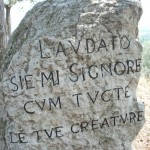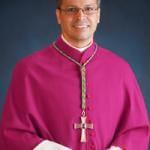Hail, glorious St Patrick
Who fell from the attic
And broke his bum-batic
On St Patrick’s Day!
That’s the way my Boston Irish(ish) parents used to wake us up on March 17. A little rude, a little pious: the epitome of Boston Irish Catholicism. And even though we lived in Hollywood, and not the traditional Irish strongholds like Boston or New York, a weekday March 17 was worth the waking up. For Catholic school kids in the Archdiocese of Los Angeles–then, as until all too recently, mission territory for Irish-born clergy–this was a Day Off. They called it Pastor’s Holiday, to avoid the impression of favoring St Pat over the Italians’ St Joseph’s Day two days later, but as all the pastors in the Archdiocese were Irish, nobody was fooled. And March 17 brought not only the prospect of a day free of school, but–Hail, glorious St Patrick!–it was a day of dispensation from Lenten regulations. Friday? Corned beef and cabbage, no problem! We stuffed ourselves with forsworn chocolate and watched reruns of I Love Lucy on the forsworn television all day. Bliss!
And all this in honor of a guy who wasn’t . . . ahem . . . actually Irish.
I used to enjoy the irony, because I was always pretty ambivalent about being Irish. Our little nuclear family was never culturally Irish in any real sense other than drinking (and faithfully taking The Pledge every year, before just as faithfully breaking it). Oh sure, my parents met at a dance at the Hibernian Hall, but who in post-War Catholic Boston didn’t? We were nowhere near as Irish as my best friend Mary Ellen Brennan’s family. Her mom was born in Ireland, and relatives with names impossible to spell and brogues impenetrable to comprehension were always arriving to live in their spare bedroom for a few weeks till they got jobs.
In any case, our family was half-and-half in the worst sense. My maternal grandparents, who lived with us, were the Irish spitfire Maggie Sullivan and the 10th-generation New England Congregationalist Herbert Kinsman. They were like having The Troubles in the middle of the kitchen. When Nana was mad at her husband, which was often, she’d call him a bloody Englishman and stage a one-woman Easter Uprising. My father was born in England of recently emigrated Northern Irish Catholics, or so we were told, whose genealogy could be traced back to (McPortland to McPartland to MacParthlan) to Partholon, the great-great-grandson of Noah’s son Japheth. My son won a contest in a sociology class once, by tracing his family tree back further than anyone else, to the Flood; he could technically have taken it back to Eden, but didn’t want to brag.
We learned this history from my father’s cousin, Father Peter McPartland, who was the North American Provincial of the Columban Mission Society, editor of The Columban magazine (which arrived free via our family connection, and was, with The Annals of the Holy Childhood, a great source of information on pagan babies), and a respected genealogist. He was also the only member of my father’s family my mother considered respectable enough to visit us. I remember him as a gentle, intelligent man who taught us to play tic-tac-toe and do magic tricks, and who startled us by shedding the stiff Roman collar and rabat to reveal a sport shirt with the sleeves rolled up, and joining Dad in a shot and a beer. Once a year, we all dressed up and went for tea and sherry to the Columban Fathers’ lavish mansion in the Los Feliz hills.
So we were Irish in a fairly uncomplicated way–until, that is, my mother took a notion that we ought to be more ethnic. (This started with our own ethnicity, but didn’t stop there. At various times, she also wanted us to be Jewish, Japanese, or Native American, all cultures she felt a strong enough affinity for to believe she had been part of them in previous lives.) Her notion coincided with the arrival of one of Mary Ellen’s distant relations, a world-renowned teacher of Irish stepdancing. Perfect! My mother thought. I could take lessons and, at 11, Irish us all up by osmosis. And that is where my Irish PTSD began.
Mary Ellen needed no lessons. At 12, she was already the possessor of fistfuls of ribbons and shelves full of trophies. St Patrick’s Day mornings found her tapping out a rapidfire blur of a hornpipe atop the L.A. City Council’s meeting table, for the entertainment of Mayor Sam Yorty and his cronies. The local TV news covered her, live. And this was, remember, in the days long before Riverdance glitzed it up with sequins and those hideous fake corkscrew curls the girls all wear now. Irish dancing back then was pure and tough and amazing. And I was utterly incapable of it.
Mary Ellen came to class so I wouldn’t feel lost. Our teacher, Ann Sullivan, who later married Mary Ellen’s brother Jimmy, was world renowned for a reason. But though I duly learned the patterns (and can to this day count out the difference between a jig and a reel) there was no magic in me. After a year’s worth of lessons, we were set to compete in our first feis. My mother paid for the costume (a simple green tunic dress with a green capelet lined in gold satin) and the shoes (ballet flats; no need for fancy high-heeled hornpipe tappers for me), but I think she was already feeling the call of kreplach and Hanukkah bushes by then. We competed. Mary Ellen won more ribbons and trophies. The judges handed me my score. I placed 6th–out of four competitors. I was That Bad. By tacit agreement, I quit the lessons, so as not to bring Ann’s curve down any further. For years, I couldn’t listen to Irish music, and when, on Friends, Chandler confessed that his greatest fear was “Michael Flatley, Lord of the Dance,” I stood up and cheered.
I stopped feeling guilty about preferring the English side of my genetic makeup to the Irish, to the point of visiting England and Scotland and even, for a while, becoming an Anglican. But I always did want to know more about the Irish half–Maggie’s family, and where my father’s parents had lived before they came across the Irish Sea to Barrow-in-Furness, England, where he was born. Figuring St Practice Night (what they call March 16 around these parts, where the University of Dayton students’ St Pat’s bingeing is, like Irish voting, notoriously early and often) was as good a time as any to dig around, I went online to ancestry.com last night. And what did I learn?
That I, like St Patrick, am nowhere near as Irish as the legends would have it. He was a Romano-Briton, probably from Wales. My family tree–even on the Irish side, even the Sons of Partholon!–is much more English than we knew. My grandmother Maggie’s grandparents, not her parents, were the immigrants off the Irish boat; her roots were almost as deep in New England soil as the bloody Englishman’s. On my father’s side, I’m English four generations back, not just one. The McPortland/McPartlands were established in and around the Barrow peninsula, working in the great shipyards, long before my father’s birth. In fact–and this was an especially moving discovery–my paternal great-grandfather John McPartland of Ulverston, Lancashire, is one of the thousands for whom England wears the poppy, having lost his life in the Great War helping to secure the ruined town of Guillemont in the last days of the Battle of the Somme. That was in 1916, the year of Easter Rising. While Yeats’s terrible beauty was being born, Irishmen like John McPartland were dying for crown and (another) country.
So I’m relieved. I’m not letting down the side by refusing to paint shamrocks on my face, wear a Kiss Me, I’m Irish t-shirt, and swill green beer, let alone grabbing partners for the Siege of Ennis when I hear a reel (though, by damn, I can still count it out). I can love the Irish things I love–“Danny Boy,” Jameson’s neat, Yeats and Joyce and Oscar Wilde, The Book of Kells, The Breastplate of St Patrick (which he didn’t compose, any more than St Francis composed the Peace Prayer, but they’re both in precisely the right spirit), The Quiet Man and Darby O’Gill and the Little People and The Commitments and The Secret of Roan Inish, Enya (yes, Enya), Guinness at breakfast, the memory of my grandmother Maggie singing “I’ll Take You Home Again, Kathleen” and of Mary Ellen’s flashing feet on the Council table–the way the sainted Patrick did, with a British heart kidnapped.
What Patrick found in Ireland, after all, is what the world finds in Patrick: God. On this Pastor’s Holiday, I wish you the bliss of that finding, no matter where your family tree is rooted. Here’s video I stumbled on that says that beautifully, to Eleanor Hull’s 1912 English version of words that may go back to Patrick’s own day:











